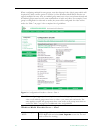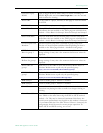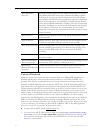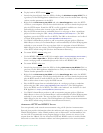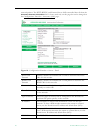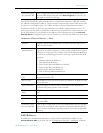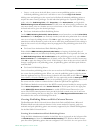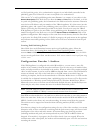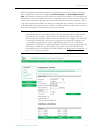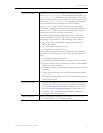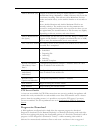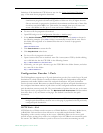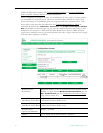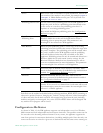
50 © 2008 VBrick Systems, Inc.
and Pull publishing points. Also, authentication support is not individually controlled at the
publishing point level. Either all or none are required to be authenticated.
Click on the "
+" to add a publishing point name. Rename it to a name of your choice in the
Source Description field. Helix does not allow the Host and Port fields to be blank, so if this
is a push only publishing point, the information in the fields need not be accurate. Otherwise
enter the host IP address and port number of the VBrick appliance. If a client tunes into the
publishing point, and a push to the publishing point is not active, the Helix server will try to
initiate a pull using the information provided in the fields. You can now setup the VBrick
WM Appliance to push to the new Helix server publishing point. Remember to use the port
number configured in the Helix server in the IWS
Server Name or IP Address field on the
appliance configuration. Helix employs a first come first served scheme, where the first client
to push wins. In a Push/Pull scenario, if a Pull is in progress, the push status on the appliance
may indicate successfully pushing but the Helix server will serve information from the pull
session.
Creating Pull Publishing Points
Since Helix does not differentiate between push or pull publishing point, follow the
instructions above for Creating Non-Authenticated Push Publishing Points
, and enter
accurate Host and Port fields. Note that for dual encoder WM Appliance models, the Helix
server can only pull from a Slot1 encoder source. Slot2 sources cannot be used to pull from using
a Helix server.
Configuration: Encoder > Archiver
If the WM Appliance is configured with a 60 GB hard drive, you can create a .wmv file
archive of any stream(s) from the encoder or reflector. You an select any or all enabled video,
audio, and script streams to be included in the archive. When an archive file contains multiple
video or audio streams, it can be used for MBR on-demand from a server. The WM Archiver
creates an indexed .wmv file on the hard drive as the WM stream is encoded. Once the
archiving is complete, the file can be transferred to a Windows Media Server via FTP to make
it available for on-demand streaming from a publishing point on the server. The file can also
be transferred to a Windows system and played locally by Windows Media Player. When a
Microsoft server serves a file that was encoded with multiple bit rates, the Media Player can
select and play only those streams that meet its available bandwidth profile.
Dual WM encoder models have two archivers to allow both encoders to save their stream to
disk at the same time. In the case of a dual mixed encoder model with WM and MPEG-2, the
MPEG-2 archiver also allows only encoder recording. It cannot record from the network.
The archiver can be stopped and started without affecting multicast, RTSP, or HTTP
streaming.
Note that any change in the configuration settings for any of the video encoders (or a stream
disruption such as when a reflector is archiving and the push source stops) will cause a brief
interruption of the video and audio stream. All streams being sent from the encoders
(including multicast and push) are interrupted and any active HTTP or RSTP clients are
dropped. If an archive is in progress, the file will be closed—but not stopped. When the
stream restarts after a disruption, the archiver will automatically open a new file and continue
recording the stream.
Note The WM Archiver can only archive from the local WM encoder or reflector and
(unlike an MPEG-2 VBStar) it cannot record streams from the network.



